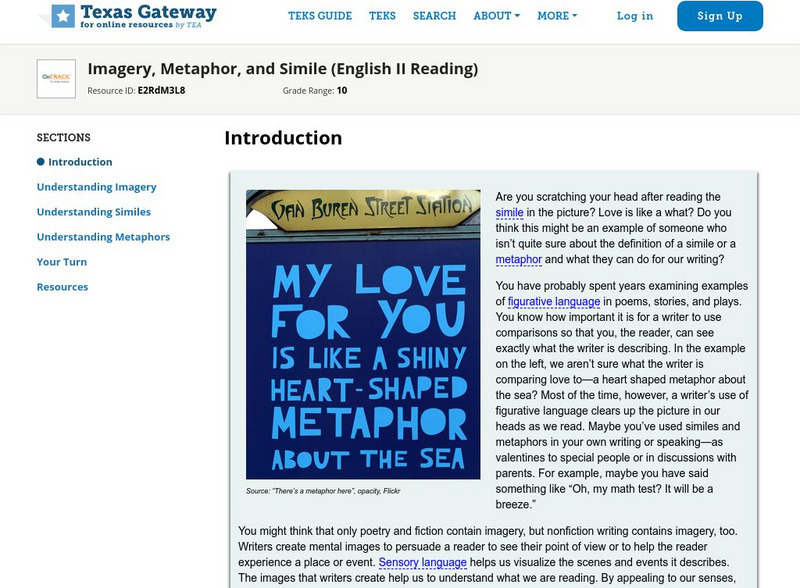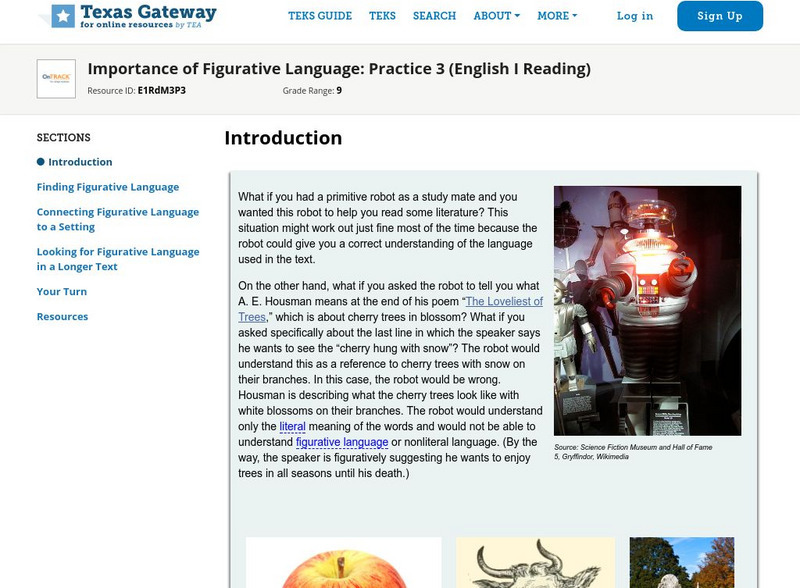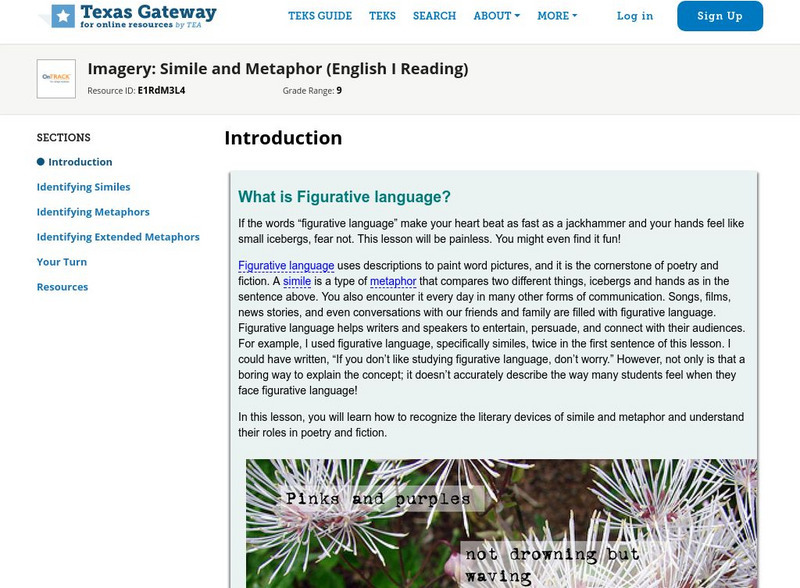Hi, what do you want to do?
Texas Education Agency
Texas Gateway: Imagery, Metaphor, and Simile (English Ii Reading)
Evaluate the role of imagery, metaphor, and simile in literary nonfiction such as speeches and essays.
Lumen Learning
Lumen: Boundless Communications: Deploying Style Effectively
This lesson focuses on rhetorical devices and how to use them effectively in public speaking. These include alliteration, antithesis, hyperbole, onomatopoeia, personification, repetition and parallelism, and simile and metaphor.
Texas Education Agency
Texas Gateway: Context Clues and Analogies (English Ii Reading)
[Accessible by TX Educators. Free Registration/Login Required] This lesson focuses on using a combination of reference materials and analyzing context clues and analogies to improve your knowledge of new words.
Encyclopedia Britannica
Encyclopedia Britannica: Literature: Personification
Explains what personification is and gives examples. Includes links to related articles on symbolism, elements of rhetoric, fables, figure of speech, and allegory.
San Jose State University
San Jose State University: Choosing Precise Words [Pdf]
This handout shows the difference between using precise words and more general words. W.9-10.2d lang/voc, W.11-12.2d Lang/Fig/Voc
Other
Study.com: Using Precise Language & Vocabulary in Informative Texts
This lesson plan focuses on using precise language in informative texts. It defines precise text and discusses how to use precise language. W.9-10.2d lang/voc, W.11-12.2d Lang/Fig/Voc
Texas Education Agency
Texas Gateway: Literary Text: Close Reading of Poetry: Practice 3
This lesson will help you comprehend the poet's meaning by giving you practice in finding imagery, metaphors, symbolism, and allusions.
Texas Education Agency
Texas Gateway: Literary Text: Imagery, Metaphor, and Simile
Writers use sensory imagery ("smelled the salty air"), similes ("like a strong man playing tug-of-war"), and metaphors ("the waves roaring in my ears") to capture the reader's imagination. In this lesson, you will learn how to identify...
Quia
Quia: Figurative Language Quiz
This 30-question quiz asks students to answer questions about figurative language by selecting the correct answer. Feedback is provided after the quiz is submitted. Java is required.
Texas Education Agency
Texas Gateway: Importance of Figurative Language: Practice 3 (English I Reading)
[Accessible by TX Educators. Free Registration/Login Required] In this lesson, you will sharpen your skill in reading figurative language and in connecting it with the historical and cultural settings in the text.
Texas Education Agency
Texas Gateway: Imagery: Simile and Metaphor (English I Reading)
[Accessible by TX Educators. Free Registration/Login Required] In this lesson, you will learn how to recognize the literary devices of simile and metaphor and understand their roles in poetry and fiction.
TED Talks
Ted: Ted Ed: The Art of the Metaphor
How do metaphors help us better understand the world? What makes a good metaphor? Explore these questions in this video with writers like Langston Hughes and Carl Sandburg, who have mastered the art of bringing a scene or emotion to...
Alabama Learning Exchange
Alex: Plath, Personification, and Figurative Language
This project based activity will use Sylvia Plath's poem, "Mirror", to examine the use of personification and figurative language. The activity may also incorporate the use of technology to produce a multimedia project. This allows...
Alabama Learning Exchange
Alex: Literary Elements in Literature
This lesson is applicable to any story or novel in literature. The learners will be introduced to twelve literary elements through a podcast. They will then be divided into small groups to complete activities involving story and literary...
PBS
Pbs Learning Media: Literary Elements and Techniques: Figurative Language
Discover how authors use figurative language to enhance their writing and explore the differences between similes and metaphors in this animated video [3:37] from WNET. Discussion questions below help students to further apply their...
PBS
Pbs Learning Media: Literary Elements and Techniques: Imagery
Explore the literary technique of imagery to see how sensory language contributes to the meaning and feeling of a poem in this animated video [1:23] from WNET. Discussion questions below help students to further apply their understanding...
PBS
Pbs Learning Media: Literary Elements and Techniques: Symbolism
Explore how authors use symbolism to add a deeper level of meaning to their work in this short animated video [1:12] from WNET. Discussion questions below help students to further apply their understanding before analyzing a text.
Quizlet
Quizlet: Flashcards: Figurative Language Level 1
Practice learning figurative language using these audio-enabled flashcards with literary terms and their definitions. Also provided is a list of terms and definitions (audio available) and links to games and a test. Java is required....
Ted Nellen
Cyber English (By Ted Nellen): Imagery
This is a glossary entry that defines the term "Imagery."
Ted Nellen
Cyber English (By Ted Nellen): Juxtaposition
This is a glossary entry for the term "Juxtaposition" including multiple definitions.
Ted Nellen
Cyber English (By Ted Nellen): Metonymy
This is a glossary entry for the term "Metonymy" including a definition, an example, and a link to Wikipedia.
Ted Nellen
Cyber English (By Ted Nellen): Synecdoche
This is a glossary entry for the term "Synecdoche" including a definition and an example.
Writing Fix
Writing Fix: Serendipitous Simile Generator for Stories
With this writing prompt generator, students will create similes that inspire an original story or a description.
Writing Fix
Writing Fix: Right Brained Lesson: Serendipitous Love Metaphors
Based on its title, student writers predict what Benatar's song means when it says that "Love Is a Battlefield." After discussing Benatar's extended metaphor as a class, students will create an original extended metaphor about love in...





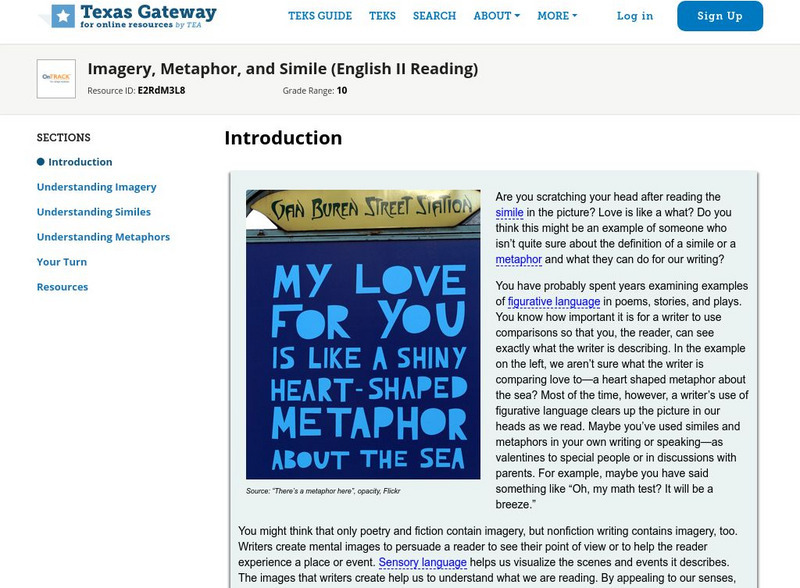


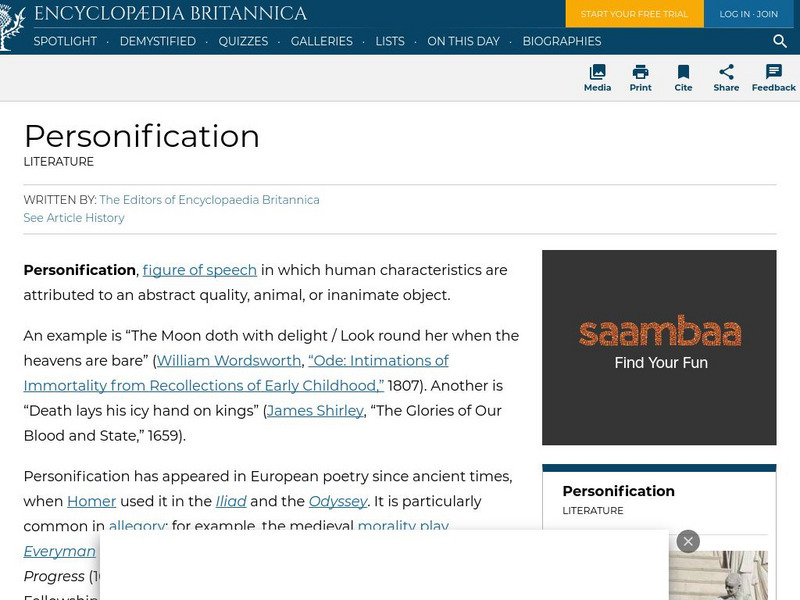
![San Jose State University: Choosing Precise Words [Pdf] Article San Jose State University: Choosing Precise Words [Pdf] Article](https://static.lp.lexp.cloud/images/attachment_defaults/resource/large/FPO-knovation.png)


